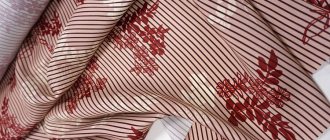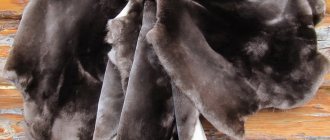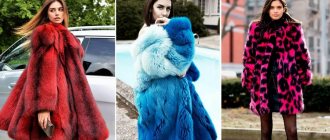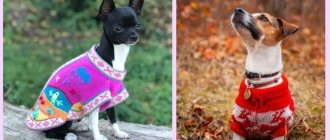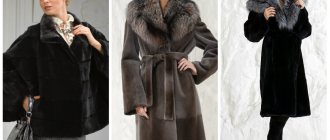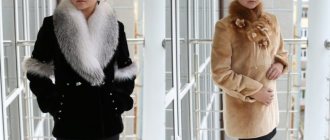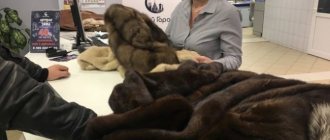In the 60s in the USSR, it was prestigious to have a fur coat made from a mouton or, as they used to say, from a tsigeika. This fur is still popular today. But from its name it’s difficult to understand from which animal’s wool fashionable outerwear is made. Not everyone knows that “mutons” are not some exotic animals that live in forests, but a domestic animal that is well known to everyone.
Based on the opinions of experts and studying reviews, we found out the main properties of a mouton, figured out how warm, beautiful fur coats are made from animal wool, how to choose a fur product from a mouton, how to care for it and what to wear it with.
What kind of fur is a mouton?
You may be disappointed, but the animal that produces this oddly named fur is the common domestic sheep. Warm socks, cozy sweaters, and mittens are knitted from its wool. And not only. Outerwear is made from dressed sheepskin - skin taken from adult animals or lambs older than six months.
Depending on the breed of sheep, its age, length, and quality of wool, sheepskin can be used for leather, fur, or fur coats.
Fur sheepskin is obtained from sheep that produce fine-fleece, semi-fine-fleece, and semi-coarse wool. Outerwear is sewn from it with the fur facing out.
From the skins of animals that produce heterogeneous coarse wool with a length of 1.5 cm, fur sheepskin is made. It is used to make sheepskin coats, sheepskin coats, fur vests, and sheepskin coats with wool inside. And the mezdra - the leather part of the sheepskin - is on the outside.
The fur of a sheepskin coat is soft, but quite durable, does not fall off or wrinkle, and is resistant to moisture. In the fur industry, the light, beautiful fleece of the Romanov breed of sheep with strong flesh is especially valued.
Sheepskin leather is skins with low quality hair that are not suitable for making fur coats and fur products. They are used in leather production.
And yet, why does fur have such a strange name? In Russian language dictionaries there is the following definition: mouton (translated from French mouton - sheepskin, valukh, ram) is a specially prepared valuable sheepskin with silky, shiny hair.
In Russia, mouton is the most common type of sheepskin. It is made from Australian merino skins. This breed of fine-wool sheep is bred in Australia and New Zealand. Subsequent processing of Australian mouton using formaldehyde, which is prohibited abroad, is carried out in Russia.
There are other types of sheepskin fur, which differ in the method of dressing the skin, in the type of fleece. Most often, confusion arises when it comes to tsigeika and mouton.
Technology
Thanks to the progressive technology of processing sheepskin skins, mouton products have taken their rightful place in the fur market. Moreover, in many respects, they are almost no different from expensive fur clothing. For mouton, the skins of one type of sheep are used, which are bred only in New Zealand and Australia.
It is worth noting that sheepskin is not taken from every animal. It turns out that almost 10% of sheep do not have the required wool parameters: length and thickness. Those cattle that show the highest results are under special supervision and care.
This is a unique type of sheep whose fur is very durable and does not allow cold to pass through.
How does mouton differ from tsigeika and astragan
As we have already found out, a mouton is a processed, cut to a certain length, ennobled sheepskin of fine wool Australian merino with very thin and soft hair. After special dressing, the skin with a velvety glossy pile becomes lighter and more impressive. In some ways it is not even inferior to valuable breeds of fur.
Mouton can be cut or full (uncut). The length of the fibers of the latter is 1-1.2 cm. This is a very warm fur that will warm you up in 30-degree frost. The fibers of a cropped mouton are shorter - 0.6-0.8 cm. And the fur is less warm.
Tsigai fur products are made from sheared sheepskin of the Tsigai breed of animals. Initially, this was the name for refined goat fur (ziege - goat in German).
In the USSR, tsigeika was very popular. It was made using almost the same technology as the mouton: the fur was trimmed and dyed brown or some other dark color. But they didn’t treat it with formaldehyde. The pile turned out to be coarser, the products were heavier, not as strong and wear-resistant as those made from mouton.
Astragan fur is a type of mouton. It is produced using special technology using fine fur of the highest quality. Its peculiarity is twisted curls up to 7 mm long. Fur coats made from this material are lighter, more durable, and more expensive than mouton ones. It is recommended to wear them at temperatures down to -10 degrees.
To visually determine what kind of sheepskin a product is made from, you need to look at the height of the pile and its characteristics. For example, tsigeyka feels rough, heavy, and feels warm. Astragan with shorter hairs and pronounced curls is softer. Mouton products are characterized by smooth fur without curls. They are lighter than cigeaceae, but heavier than astragan.
What standards are used in production? What do they take into account?
Mouton is made using technology developed in Russia. The material is made on foreign equipment under strict control.
Technical requirements for the manufacture of sheepskin are specified in GOST 4661-76:
- Process the skins according to the configuration and straighten them evenly.
- Clean the leather fabric thoroughly and stretch evenly.
- Smooth the pile in one direction and work on its upper part. The pile should be shiny, cleaned, combed and crumbly.
- Sew up the tears while maintaining the symmetry of the skin.
- Straighten the seams carefully. Their height is no more than 2 mm.
How to make a mouton
The technological process consists of several steps. Animal skins removed in a single layer are cleaned, straightened, preserved, sorted, processed, dressed in a special way, and soaked in formaldehyde.
At the last stage, the skins are stretched, the edges are aligned, combed, the fur is carefully trimmed, and the pile is dyed in different colors: from white to charcoal black, brown. The result is durable, smooth fur with a plush dense texture that is resistant to friction, moisture, and mechanical stress.
According to one version, turning sheep skin into elegant thin fur was first possible in Germany, according to another - in France. Be that as it may, the new technology using formalin, which gave fur not only practicality, but also tenderness, very quickly spread everywhere. And it improved over time. They have learned to process sheep wool in such a way that it is difficult to distinguish it from elite fur.
What is sheepskin and how is it obtained?
Sheepskin is a tanned sheep skin taken from an animal older than 6 months. This is the most valuable raw material obtained from sheep slaughter. The animal is laid or suspended, bled, cuts are made along the chest and abdominal cavity, along the inside of the limbs, and the skin is removed in a single layer. Then it is cleaned, straightened and preserved no later than 2 hours after removal. This allows you to stop the growth of bacteria and reduce humidity, preserving perishable raw materials during long-term storage.
Sheepskin
Then the skins are sorted and processing begins. Its main stages:
- Soak. Canned raw materials are soaked until soft and elastic skin (mesh) is obtained. By soaking, it is also cleansed of dirt, salts and preservatives.
- Fleshment. The subcutaneous fat layer, remaining meat and tendons are removed. During the process, the fibrous part of the core softens, which makes it easier to process with chemicals in further stages.
- Degreasing. Produced to remove dirt and sebum from the skin. For this purpose, fat solvents and surfactants are used.
- Pickling. The process involves treating hides with a solution consisting of acid and table salt. It allows you to break down the collagen fibers of the skin, making the inner layer softer and more flexible.
- Tanning. Treatment with tannins gives the raw material strength, wear and heat resistance, and water-repellent properties. To do this, use chemical compounds (chromium sulfate and oxide, potassium bichromate) or natural substances with a high tannin content - oak, willow or alder bark.
Tanned sheep skins
Description and characteristics
Fur processed using new technology with a high pile density looks flawless, does not wrinkle, and does not change direction. It is used to make practical, durable, weather-resistant sheepskin coats, mantles, fur coats, and fur coats that can last 5-8 seasons. And even more.
This is a light and warm material - in this parameter it is inferior only to beaver or sable. It is comfortable in both warm autumn and winter cold. Does not blow out in strong winds. The fur looks good even with everyday wear, does not pill, is moisture resistant due to the treatment of the fibers with a formaldehyde solution, and is well breathable. Wool dyes well - designers take advantage of this when coming up with models of different colors.
Features of fur
Fans of winter clothes are interested in the question of what animal are mouton fur coats made from, and what are the advantages and disadvantages of the product. The animal whose wool became the basis for sewing mouton products is a ram. Previously, the fur of this animal was used for the inside of clothing, since it has the property of retaining heat well.
The word “mouton” came to us from the French language and translated means “ram”. The animal must be young so that its fur is soft and easier to process. The result is luxurious, delicate fur, not inferior in appearance to expensive elite skins.
The material can easily withstand various weather conditions, such as sleet and rain, as it has increased strength and resistance to wear.
What is sewn from mouton
Outerwear of any style and warm winter accessories, which are comfortable in cold winters, are made from refined fur fabric with a plush surface.
- These can be short jackets with or without a hood.
- Boleros are warm, beautiful mouton capes for cool autumn or spring weather that can be worn with different clothes.
- Short fur coats made of mouton - a shortened cut of a loose silhouette or a tight-fitting style with or without a hood, with long or short sleeves, in combination with fox, silver fox, and raccoon fur.
- A mouton coat is an elegant outerwear made of beautiful warm wool. The styles are varied: classic, fitted silhouette of moderate length, oversized, with or without a belt, with a hood, trimmed with the fur of other animals.
- Mouton vest - fur sleeveless vests in both short and long versions. Loose and tight. With the use of other decorative materials in finishing.
- A mouton sheepskin coat is a fashionable and popular women's outerwear.
- The prototype of a modern sheepskin coat is sheepskin coats, which were sewn from sheared sheepskin. In them, the fur, which serves as lining and insulation at the same time, remains on the inside.
- Fur coats of various styles and models: straight long, flared downwards, combining classic with fashionable details, hood and belt or without these details, collar and trim with mink, silver fox.
- Collars are sewn from fine-fleece and semi-fine-fleece sheepskin with fur on the outside; warm hats and berets are made from sheared sheepskin fur in combination with jacquard textiles and leather.
- A warm and beautiful accessory that complements the winter look is mouton mittens.
What purposes can this fabric be used for?
Used for sewing fur coats, sheepskin coats, as well as fur accessories and hats.
Things from mouton
How to choose a fur coat from a mouton
What do women pay attention to when choosing a fur coat? To make it warm, practical, light. But the main thing is fashionable, beautiful, stylish. If the initial purpose of the purchase is to stay warm in winter, a warm mouton coat is just what you need.
The wear resistance of the material is an important parameter if you are planning a purchase seriously and for a long time. A fur coat made from a mouton will last on average 5-10 years. How long depends on the quality of the fur, how it is processed, and how to care for it.
A high-quality fur coat should be light - many people pay attention to this. But this is a relative indicator: it depends on the type and quality of the skin, and on the length of the fur. For example, a polished sheepskin coat is always heavier than a mouton fur coat, and outerwear made from high-quality sheepskin is always heavier than items made from faux fur.
Fur quality
A very important parameter that determines how long the new thing will last. The fur should be dense, thick, smooth, shiny, soft, uniform without bald spots, bald spots, or paint stains.
It could use a little beating. The villi should not be pulled out. And especially to come out in large numbers. The fur should not be crushed and will immediately return to its original position if you run your hand over it against the pile. If something is wrong, the fur may be of poor quality. The thing will not last long and is unlikely to keep you warm in winter.
Tailoring quality
It is always necessary to check how well a fur coat is sewn, regardless of the popularity of a particular manufacturer. Pay attention to how tightly all parts of the fur coat are connected to each other, which should be sewn using the “skin to skin” method, and not glued.
The seams connecting the parts of the fur coat should be soft to the touch, elastic, flat, without moving edges or protruding threads, and can be easily felt even through the lining. If this is not the case, there is a risk of running into glued fur. After a couple of seasons, individual pieces of skin may fall apart at the seams.
The lining of a fur coat should be thin. The seams that connect it to the fur coat, to the hood, to the pockets are straight and neat.
Wanting to save money, some manufacturers use low-quality fur in lapels. This also needs to be checked. And also how and how securely buttons, hooks, decorative elements, and zippers are fastened.
Paint quality
All mouton fur coats are dyed in different colors. If everything is done according to technology using high-quality dyes, the fur remains elastic and shiny even after dyeing. Retains color for a long time and does not fade.
You can make sure that everything is in order here by running a piece of light cloth over the fur. If there are no traces left on it, good.
Style, length, color of fur coat
It is advisable to sort this out before purchasing. But if you follow the general recommendations, the length of the fur coat (unless it is a short fur coat or jacket) should correspond to height. As for the fur color and style, designers recommend choosing models closer to the classic ones, in a neutral color, for everyday wear. This makes it easier to combine outerwear with shoes and other things.
A few recommendations
The risk of counterfeiting a fur product on the market is much higher than in a specialized store. In the store, the buyer will be shown a product quality certificate confirming the safety of the product, which has passed all required tests. As well as a warranty card and all necessary documents that may be required in case of returning a fur coat.
The label on the lining of the product should contain information about the country of manufacture, the product itself, and recommendations on how to care for it.
What to look for when choosing a fur coat
Modern technologies make it possible to dye fur in various bright, spectacular and stylish colors, maintaining its shine and elasticity. Mouton fur coats are made in various styles and colors. The length of the fur coat should correspond to the height of its owner, and the color of the fur should be selected on the basis that the younger the girl, the lighter the mouton should be. If a fur coat is chosen for daily wear, then it is better to give preference to classic models and colors. This product can be combined with any clothing. In order not to make a mistake with your choice, you should pay attention to the quality of the fur.
- The fur should not be plucked, deformed or matted. To check this, it will be enough to take a piece of material with your fingertips and lightly pull it towards you.
- High-quality mouton fur coats are sewn so that the seams in them cannot be felt and are elastic. This gives the product a neat appearance.
The material allows you to create products with original, interesting details and complex cuts. At the same time, the fur will retain heat well. All these advantages make fur products in demand and popular.
How to distinguish a mouton from a fake and faux fur
Modern mouton fur coats are sewn and processed using modern equipment. They are very light - they weigh about two kilograms and do not look bulky. Based on these characteristics, they can easily be confused with artificial fur coats. But, unlike them, natural mouton retains its main qualities - wear resistance and the ability to warm in the cold. These are complete winter items.
Not a mouton fur coat at all, but something very similar to it, there may be Polish, Turkish, Chinese products that are sewn from cheap sheepskin, usually used for sheepskin coats. In such skins, first of all, the quality of the skin is valued, not the fur. But manufacturers pass them off as real mouton fur coats, turning the sheepskin over with the fur facing out.
They are dyed dark to hide the flaws of low-quality fur. Often, instead of fur dyes, dyes for suede and leather are used. After a couple of seasons, not a trace will remain of the beautiful rich color.
Such mouton-like fur coats made from ordinary sheepskin with thin flesh and sparse fur are of low quality. Products made from them, although natural, are not warm enough. More suitable for European winters with temperatures hovering around zero. Sometimes they are insulated with padding polyester. Insulated sheepskin is one of the signs that this fur coat is not made of mouton.
Compared to artificial fur coats, artificial fur is much longer. It must be secured to the base.
The shine of fur is another indicator: although artificial material shines, it does not look entirely natural.
Natural fur and products made from it are always heavier than those made from artificial material. Although modern mouton products, if you compare them with the heavy sheepskin coats from the times of the USSR, are also quite light.
Popular colors
Many models of classic shades:
- black and white, light colors;
- the trend is gray – silver, steel and graphite shades;
- Warm colors are popular - all shades of brown, red, and gold.
Mouton is easy to color, so there are many models painted in bright and original colors.
Dyed mouton fur coat
The following trends can be identified in the 2021-2021 season:
- green, blue, pink tones;
- rich red and purple shades;
- prints, such as animal prints, leopard or zebra.
Any fashionista can afford a bright and inexpensive fur coat.
Light mouton fur coat with stand-up collar
Custom fur coats
Fashionistas of all ages often refuse heavy fur products. You can go anywhere in an elegant light fur coat: to work, for a walk. Everywhere it is comfortable, beautiful and warm. If we are talking about modern lightweight models made of mouton.
In order to preserve the main quality of a fur product at low weight - to keep you warm in winter, they are sewn from the skins of young animals. To do this, small skins are tanned and stretched. They become practically weightless. To make the item warmer, manufacturers sometimes use additional lining.
Lightweight fur coats weigh little, look good, are practical, and are inexpensive. The downside is that their service life is significantly shorter than that of their heavier weight counterparts.
Sometimes fur coats are made without skinning the animals. In this case, the wool is simply cut off. The resulting fur is processed and applied to a fabric base. To prevent the fur fabric from absorbing dirt and moisture, it is treated with special products. A product made from sheared wool is light, beautiful, and inexpensive. In the wake of humane treatment of animals, such clothing is in demand.
Of course, they are not as warm as natural sheepskin coats. Depending on the percentage of wool in the material, they can be worn at temperatures down to -10 degrees. Sometimes they use additional insulation.
Fur coats made from sheared wool are inferior to natural ones made from sheepskin in other respects: they do not absorb moisture well, are not as durable, become electrified, and synthetic materials in the composition can cause allergies.
Production
- The first stage of sheep skin processing is fleshing (cleaning the skins);
- Then, they are placed in a special drum, which rotates for several hours. Thus, the skins are given softness. After two stages of processing, such material is suitable for sewing ordinary sheepskin coats;
- The third stage is stretching the skin. At the same time, they do not lose their basic properties - strength and elasticity. On the other hand, the skins acquire a larger area, which makes it possible to use fewer seams when sewing products;
- The next stage of refining sheepskins is formaldehyde treatment. This method of processing sheepskin was invented to make the fur moisture resistant. In this case, the fur coats will not be afraid of rain, snow, or changes in temperature. I would like to immediately tell fashionistas that the use of formaldehyde when processing sheepskin is not dangerous to humans. Immediately after this treatment, the skins are cleaned of all chemicals;
- After this treatment, the skins are sent for painting. The fact is that natural color is not very attractive. Today, thanks to modern technologies, a mouton can be dyed in any rich color.
Also, with the help of new technologies, it is possible to make thick mouton fur light, which makes the product more comfortable.
Now production technologists cut the sheepskin and smooth the wool using a special method. After this, it acquires an unrecognizable chic look, the fur of which can only be recognized by specialists in the fur industry.
What to wear with a mouton fur coat
Nowadays they sew such fur coats from mouton that women wear them with pleasure with different clothes. Warm, light, flowing, of different styles, with mink and silver fox collars. The main rule is to put together a harmonious, stylish look in which things go well together.
Short jackets can be worn with jeans, trousers and even skirts. Short fur coats to the knee and slightly below go well with a skirt. But here you need to successfully choose the length and style of the latter. You can wear anything under a long fur coat.
Depending on the style and length of the product, appropriate shoes, suede or leather gloves, hats, the role of which can be played by a hood, and bags, are selected.
If you read what women write in reviews, the main idea can be formulated as follows: of course, you need to follow fashion. But a fur coat, first of all, should decorate a woman. And do not spoil its appearance in any way.
In general, owners of fur products made from mouton note the following qualities among the advantages:
- practicality - retains good appearance and shape even with constant wear in different weather conditions;
- fur coats are stylish, beautiful, fashionable - suitable for any age;
- very warm and light - they are comfortable in cold and windy weather;
- long service life - your favorite clothes will delight you for many years;
- affordable price.
There are practically no disadvantages if the fur coat has high-quality, correctly dyed fur and is professionally sewn in compliance with technology.
Pros and cons of fabric
Pros:
- The material is very warm and will keep you warm in severe frosts.
- The finished product is suitable for wear for up to 10 years, thanks to the dense structure of the hairs.
- Increased strength.
- Soft texture and shiny fur.
- Wear resistance. Mouton does not lose its appearance even with different types of processing.
- Affordable price compared to other types of fur.
Minuses:
- Fur is heavy due to the density of the material.
- The use of formaldehyde in dressing - due to its harm, mouton was no longer produced in Europe.
- Conservative clothing models. The style of fur coats has changed little since the 80s; it will be difficult to find a fashionable and original design.
- Requires careful care.
Recommendations for product care
In terms of durability, mouton fur coats are second only to otter fur. They can last up to six seasons. But this is only if the fur product is properly cared for, stored and protected. Care information is on the tag.
What not to do:
- the fur will dry out and quickly become bald if you constantly carry the bag on your shoulder;
- never dry a wet fur coat near heaters, radiators, do not use a hairdryer or iron - let it dry naturally in a cool, dry place;
- Do not spray antistatic agents, hairspray, perfume, or deodorant on the fur;
- You cannot store fur products in a plastic bag - only fabric covers can be used;
- You should not use narrow, flimsy hangers for off-season storage - only wide hangers that fit the size of the product and are designed for its weight;
- It is not recommended to air your fur coat in the summer on the balcony in the sun - only in the shade.
It is advisable that the closet where the fur coat hangs be spacious - otherwise the fur will wrinkle and become deformed. You need to dry clean your fur coat.
The game is worth the candle!
If you compare all the advantages of a mouton with such popular furs as mink, arctic fox and otter, it becomes obvious that clothes made from a mouton are not an alternative to expensive furs. This is a full-fledged representative of the most popular part of the fur industry. Mouton is becoming more and more popular from season to season. Products made from it are suitable for both men and women. Clothes made from mouton are worn by children, teenagers, respectable women and men. Mouton became an ageless fur. Its durability to wear, ease of care and variety of colors and patterns make this fur truly valuable.
Mouton is a specially prepared sheepskin fur that is distinguished by its smoothness, silkiness and increased shine of the hair. It is used for sewing fur outerwear for women and men, finishing shoes, and various accessories. The material has a thick and dense pile, which is quite heavy, which does not always suit the consumer. That is why lightweight mouton has recently been used to sew light sheepskin coats, coats and vests.
Fashionable styles
Cross-cut mouton fur coats, made from strips of equal width that overlap each other, look fashionable and stylish. The style looks elegant and modern (especially if the fur coat is complemented by a stand-up collar), emphasizing the refined taste and femininity of its owner.
Ladies who are overweight should not purchase cross bands, as the outfit can add unwanted volume. The shortened car lady style is in high demand not only among ladies traveling by car, but also among young girls. The model goes well with different toilets and is convenient for an active life. A cocoon fur coat made of mouton is an interesting option for stylish fashionistas. The style of the product is unusual: a tight-fitting top, slightly flared hips and a tapering hem. The model looks elegant and is suitable for special occasions and everyday use.

